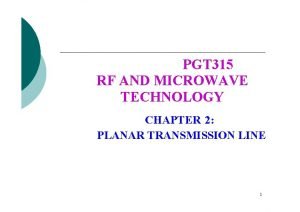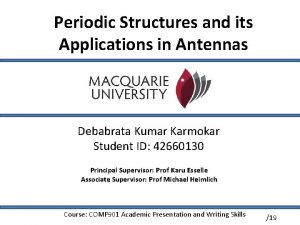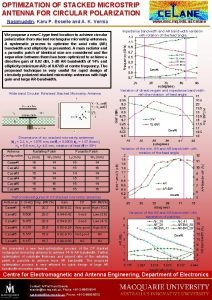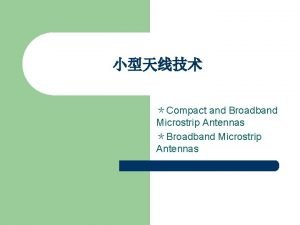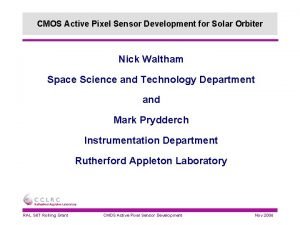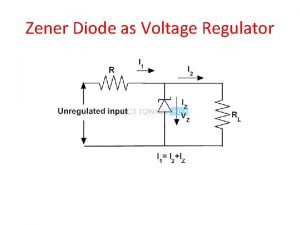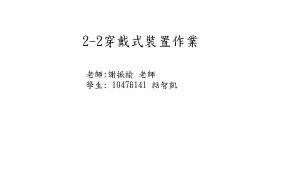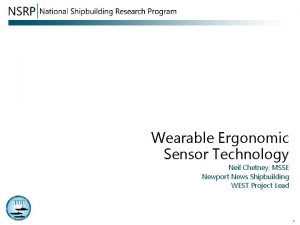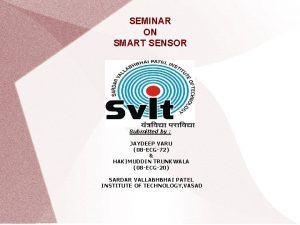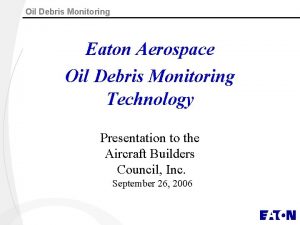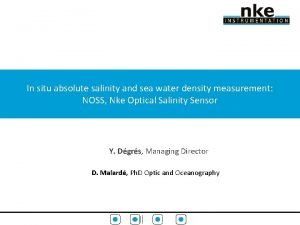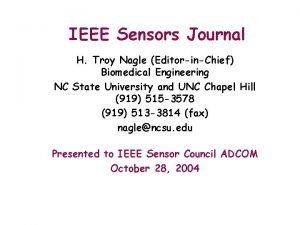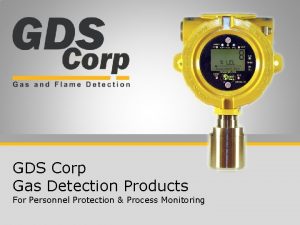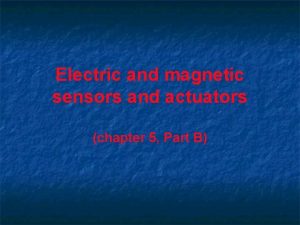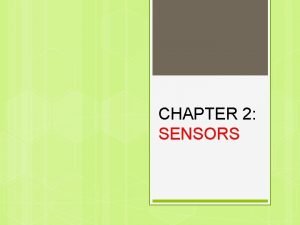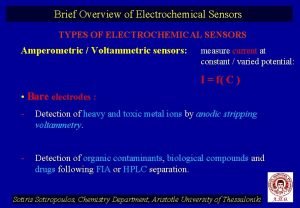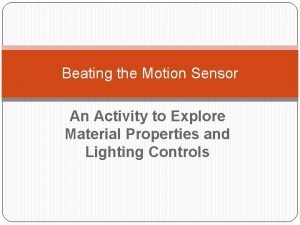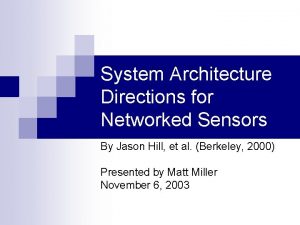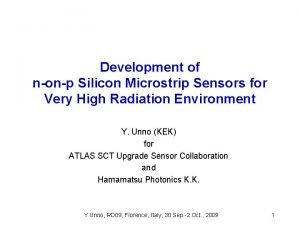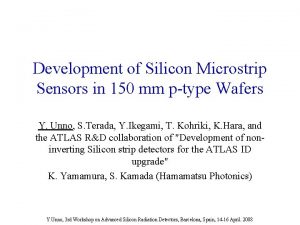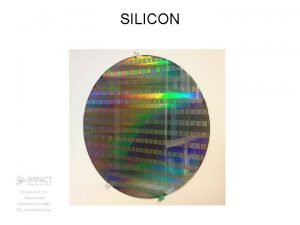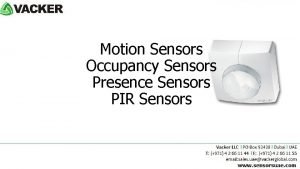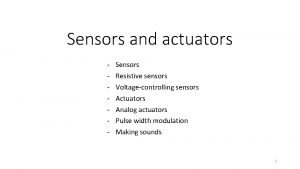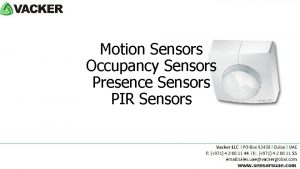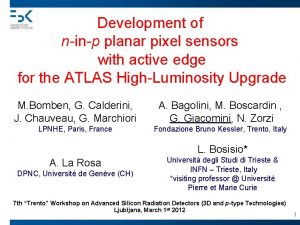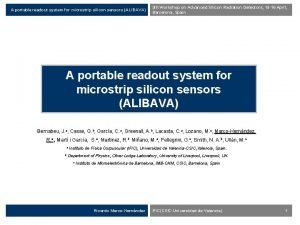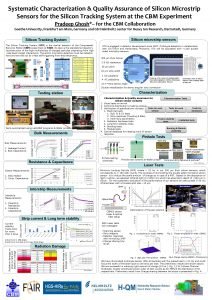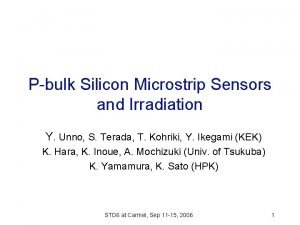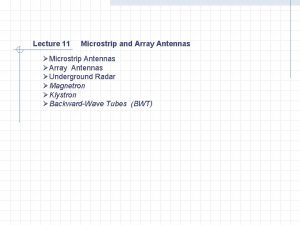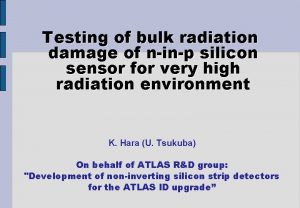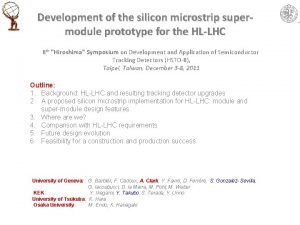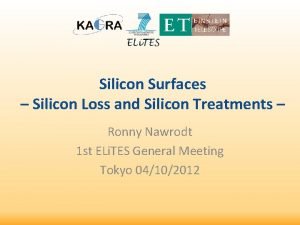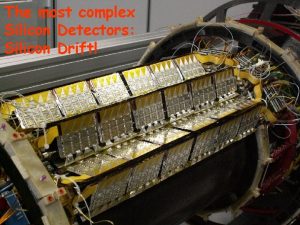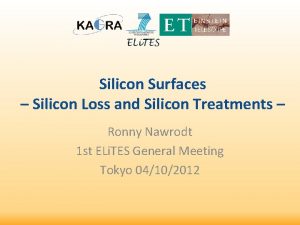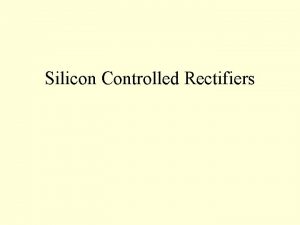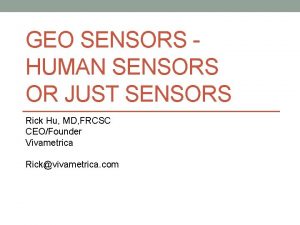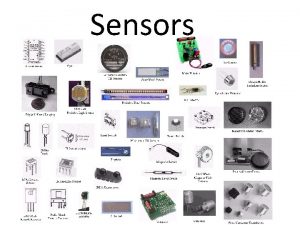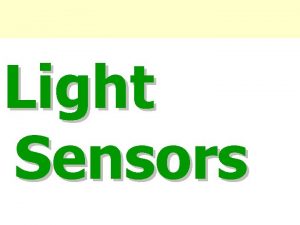Development of ninp largearea silicon microstrip sensors for























- Slides: 23

Development of n-in-p large-area silicon microstrip sensors for very high radiation environments Y. Unno for the ATLAS 12 sensor community and Hamamatsu Photonics K. K. 2013/9/3, HSTD 9, Y. Unno 1

ATLAS Tracker Layouts • Current inner tracker • Phase-II upgrade (LOI) – Pixels: 5 -12 cm – Pixels: 4 -25 cm • Si area: 2. 7 m 2 • Si area: 8. 2 m 2 • IBL(2015): 3. 3 cm – Strips: 30 -51 (B)/28 -56 (EC) cm • Si area: 62 m 2 – Transition Radiation Tracker (TRT): 56 -107 cm • Occupancy is acceptable for <3 x 1034 cm-2 s-1 • Phase-II at HL-LHC: 5 x 1034 cm-2 s- – Strips: 40. -100 (B) cm • Si area: 122 (B)+71(EC)=193 m 2 • Major changes from LHC – All silicon tracker – Large increase of Si area 1 新学術領域研究会、2012/1/6 -7、海野 • both in Pixels and Strips • ~ 3 × LHC ATLAS 2

Particle fluences in ATLAS • ATLAS detector to design for • – Instantaneous lum. : 7 x 1034 cm-2 s-1 – Integrated lum. : 6000 fb-1 (including safety factor 2 in dose rate) – Pileup: 200 events/crossing IBL (LHC) • PIXELs (HL-LHC) • – Insertable B-layer pixel – r = 3. 3 cm • Flunece ~3 x 1015 neq/cm 2 • at Int. L~300 fb-1 – – – Short strips Inner: r=3. 7 cm ~2. 2 x 1016 Medium: r = 7. 5 cm, ~6 x 1015 Med/Out: r=15. 5 cm ~2 x 1015 Outer: r = 31 cm (? ) ~1 x 1015 Charged: Neutrons ≥ 1 Long strips STRIPs (HL-LHC) – Replacing Strip and TRT – Short strip: r = 30 cm, e. g. • ~1 x 1015 – Long strips: r = 60 cm, • ~5× 1014 – Neutrons: Charged ≥ 1 2012/11/18 Y. Unno, M. Mikuz 3

Radiation Hard n-in-p Silicon Sensors • n+-strip in p-type substrate (n-in-p) – Collects electrons • like current n-in-n pixels • Faster signal, reduced charge trapping Guard Ring Bias Ring Si. O 2 – Depletes from the segmented side p-spray or p-stop • Good signal even under-depleted e- p- bulk – Single-sided process • 30 -40% cheaper than n-in-n • More foundries and available capacity worldwide n+ Un-depleted p+ Al – Easier handling/testing • due to lack of patterned back-side implant • Collaboration of ATLAS with Hamamatsu Photonics (HPK) Axial – ATLAS 07 – 9. 75 x 9. 75 cm 2 sensors (6 inch wafers) – 4 segments (2 axial, 2 stereo), 1280 strip each, 74. 5 mm pitch – FZ <100>, 320 µm thick material – Miniature sensors (1 x 1 cm 2) for irradiation studies Last symposium (HSTD 8), Y. Unno, et. al. , Nucl. Inst. Meth. A, Vol. 636 (2011) S 24 -S 30 2011 IEEE NSS, N 24 -1 Y. Unno Stereo Miniatures ATLAS 07 sensor to study axial and stereo layouts 4

Evaluation of ATLAS 07 Sensors Specification J. Bohm, et. al. , Nucl. Inst. Meth. A, Vol. 636 (2011) S 104 -S 110 Measurement Leakage Current <200 µA at 600 V 200– 370 n. A Full Depletion Voltage <500 V 190 – 245 V Coupling Capacitance (1 k. Hz) >20 p. F/cm 24 – 30 p. F Polysilicon Resistance 1. 5+/-0. 5 MΩ 1. 3 -1. 6 MΩ Current through dielectric Idiel < 10 n. A < 5 n. A Strip Current No explicit limit < 2 n. A Interstrip Capacitance (100 k. Hz) <1. 1 p. F/cm (3 probe) 0. 7 – 0. 8 p. F Interstrip Resistance > 10 x Rbias~15 MΩ >19 GΩ • All specifications already met!! 2011 IEEE NSS, N 24 -1 Y. Unno 5

Charge Collection after Irradiation • Partly with ATLAS 07 mini’s • Silicon thickness ~300 µm 500 V Long strips Annealed 80 min at 60 C – CC ~13000 -18000 e at 1× 1015 neq/cm 2 at 500 -900 V bias voltage. 90 Sr b Short strips 900 V 90 Sr • And, “Charge multiplication” – in thin sensors? H. F. -W. Sadrozinski, et al. , Nucl. Instr. and Meth. A(2011), doi: 10. 1016 / j. nima. 2011. 04. 06 Inner-most pixels b 5× 1015 neq/cm 2 140 µm Annealed 80 min at 60 C 300 µm 新学術領域研究会、2012/1/6 -7、海野 6

R&D’s in Other Wafers • In the meantime, other R&D’s were: (1) Punchthrough protection (PTP) structures (2) Least-wide edge region (“slim edge”) - HSTD 8, PIXEL 2012 S. Mitsui et al. , Nucl. Instr. Meth. A 699 (2013) 36 -40 Y. Unno et al. , Nucl. Instr. Meth. A 699 (2013) 72 -77 Y. Unno et al. , Nucl. Instr. Meth. (2013) http: //dx. doi. org/10. 1016/j. nima. 2013. 04. 075 i (1) Mitigation of “Stereo” dead area - This ATLAS 12 sensors 2013/9/3, HSTD 9, Y. Unno 7

PTP Function – Extra path Virtual GND AC-coupling Bias resistor ∆V=R*∆I ← ∆I → xxxxx GND Virtual GND AC-coupling Bias resistor ∆v=R*∆i ← ∆i → xxxxx GND e- e- ee- e- e- ∆I (=∆I’+∆i) ∆I’>∆i e- e- ee- e- e- Beam splash ∆I • With Extra path – which turns on when the voltage difference between the – Charges created by beam splash implant and bias rail is > onset. – run through bias resistor and – Voltage difference over AC– generate voltage difference coupling can be limited to the over AC coupling voltage drop that generates the turn-on. 2013/9/3, HSTD 9, Y. Unno • Without extra path 8

Novel PTP structures – Gated Half gate 1 No gate Half gate 2 Full gate • Protection of AC coupling insulator • ∆V < 100 V • KEK’s internal study with a new mask • BZ 4 B - ATLAS 07 variations • BZ 4 C – “Compartment” type variations • BZ 4 D – “Simple” type variations Y. Unno, et al. , 2011/11/14 9

New Challenge – PTP Structures Bias rail • P-stop is a barrier • Full gate - Reducing onset voltage, cut-off rate, saturation resistance Non-irradiated No gate S. Mitsui et al. Full gate - Irradiated 1 MΩ Full gate Strip • PTP - Insurance for protecting integrated AC coupling capacitors from beam splash • ∆V (Implant-Metal) ≤ 100 V Also see gate effect etc. , NP 3. M-6, C. Betancourt et al. , “The punchthrough effect in silicon strip detectors” 100 kΩ 1 x 1015 ~5 m. A 2011 IEEE NSS, N 24 -1 Y. Unno 1 x 1014 1 x 1013 5 x 1012 10 kΩ 10

ATLAS 12 M wafer layout • Main sensor at the center of the wafer • 1 -24 Baby sensors in the peripheral of the main sensor 2013/9/3, HSTD 9, Y. Unno 11

ATLAS 12 A Wafer Layout • Main sensor at the center of the wafer • 1 -24 Baby sensors in the peripheral of the main sensor 2013/9/3, HSTD 9, Y. Unno 12

ATLAS 12 Main Sensors • PTP structure • Two dicing lines: – Nominal (Blue): 910 -950 µm – Slim (Red): 450 -500 µm 2013/9/3, HSTD 9, Y. Unno 13

Mitigating “Stereo dead” Area • Corner of Segment 4 is made “AC” ganged 2013/9/3, HSTD 9, Y. Unno 14

Miniature’s Structures • Zone • PTP gate – Pitch, p-stops – A: Half, B: Continuous-Full – C: Comb-Full, D: Half+Bias – E: No gate, F: Wide gap 2013/9/3, HSTD 9, Y. Unno 15

ATLAS 12 A Endcap (EC) Mini’s • Small and Large pitch mini’s – Average pitch: 128 µm, 205. 5 µm – Dicing line • Side: Slim only (limited by available 1 cm x 1 cm) • End: Slim and STD – Stray strip gang • 12 M: no gang • 12 A: DC and AC gang 2013/9/3, HSTD 9, Y. Unno 16

EC Skewed mini • Basically, 2 cm × 2 cm • No “short/stray” stereo strips 2013/9/3, HSTD 9, Y. Unno 17

ATLAS 12 I-V after Dicing • Process finished for ATLAS 12 A 120 pcs and 12 M 45 pcs • ATLAS 12 -A 30 and –M 20 wafers were diced to - 25 “Standard” width (950 µm) and 25 “Slim” (450 µm) Standard width dicing (28 pcs) Slim edge dicing (28 pcs) ATLAS 12 M wafers ATLAS 12 A wafers • “Standard” edge dicing – Those delivered are in “spec”. • I <20µA, MD>600 V – Most are flat up to 1000 V – MD (~750 V) 2 pcs (7(± 5)% of 30) • 12 A: I-V “wiggle” at 300 -400 V • “Slim” edge dicing – Those in “spec”, – but not a whole story yet, !2 M … • Some tendency to increase current, overall and over 800 V • 12 M: I-V “wiggle” at 200 -300 V 2013/9/3, HSTD 9, Y. Unno 18

ATLAS 12 Wafer Depletion Voltage • VFDV: ATLAS 12 A ~ 350 V, ATLAS 12 M and others ~230 V – Resistivity: ATLAS 12 A ~ 3 kΩcm, ATLAS 12 M ~4 kΩcm – Different wafer lot may have affected the characteristics in subtle ways. • Measurement campaign is on-going in the collaboration, including irradiations 2013/9/3, HSTD 9, Y. Unno 19

Summary • ATLAS 12 prototype sensors – Close to the final design for the ATLAS upgrade strip sensor – PTP, Slim edge, Stereo ganging, … implemented • ATLAS 12 A and 12 M – Process finished for wafers for 120 sensors ordered – Dicing on-going • Those “in spec” have been delivered • 12 A: 5 Slim, 25 Std • 12 M: 23 Slim, 3 Std – I-V after dicing • Most are good up to 1000 V • Slim has a tendency of “turning up” over 800 V, but… – Wafer lots are different for ATLAS 12 A and 12 M • Full depletion voltages: 12 A ~350 V, 12 M ~230 V • More to be reported in the next symposium. 2013/9/3, HSTD 9, Y. Unno 20

Backups 2013/9/3, HSTD 9, Y. Unno 21

Abstract • We have developed a novel and radiation-tolerant n-in-p silicon microstrip sensors for very high radiation environments such as high-luminosity LHC. • The sensors are designed to be operable to the end-of-life fluence of ≥ 1× 10^15 1 -Me. V neutron-equivalent/cm^2. • The sensors are fabricated in p-type, float-zone, 6 in. wafers where we lay out two designs of large-area, 9. 75 cm × 9. 75 cm, strip sensors, together with a number of miniature sensors. • The large-area sensors have four blocks of short strips, 2. 4 cm long each. One design is made with all “axial” segments (ATLAS 12 A) and the other with two “axial” and two “stereo” strip segments (ATLAS 12 M). • Each design has (1) two edge-widths: standard (~900 µm) and slim (~450 µm), and (2) punch-through protection (PTP) structures at the end of each strips. • The miniature sensors are implemented with variations of the PTP structure, and the “wedge” designs for the endcap sensors with stereo strips or the “skewed” layout. • A “ganging” of stray stereo strips to the readout strips is designed in a stereo-strip segment of the ATLAS 12 M sensor and in the “wedge” miniature sensors. • We report the design and the initial performance of the large area and the miniature sensors with the standard or the slim edge dicing. 2013/9/3, HSTD 9, Y. Unno 22

ATLAS LHC Tracker Layout 2013/9/3, HSTD 9, Y. Unno 23
 Microstrip transmission line
Microstrip transmission line Microstrip transmission line
Microstrip transmission line Nasimuddin+microstrip+antennas
Nasimuddin+microstrip+antennas Broadband microstrip antennas
Broadband microstrip antennas Development of solar sensors
Development of solar sensors Asia silicon valley development agency
Asia silicon valley development agency Zener diode equations
Zener diode equations Wearable inertial sensors
Wearable inertial sensors Ergonomic+sensors
Ergonomic+sensors Smart washroom
Smart washroom Conclusion of smart sensors
Conclusion of smart sensors Monitor oil debris
Monitor oil debris Types of negotiations
Types of negotiations Peas properties in ai
Peas properties in ai Water density sensors
Water density sensors Ieee sensor journal impact factor
Ieee sensor journal impact factor Gds corp
Gds corp Kmz10b
Kmz10b Chemical sensors ppt
Chemical sensors ppt Sensors example
Sensors example Types of electrochemical sensors
Types of electrochemical sensors How to beat motion sensors
How to beat motion sensors Exteroceptive sensors examples
Exteroceptive sensors examples System architecture directions for networked sensors
System architecture directions for networked sensors
